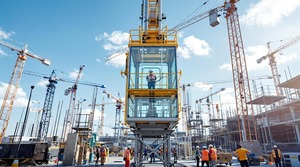Construction Hoist Safety: Best Practices for Workers
Cuerpo
A construction hoist is a vital piece of equipment on job sites, enabling the efficient transportation of workers and materials across multiple levels of a building. With the rise in high-rise construction, the demand for these hoists continues to increase, bringing both benefits and significant risks. The potential for accidents, including falls, mechanical failures, and overloading incidents, makes safety a top priority.
Workers need thorough training and a deep understanding of best safety practices to mitigate these hazards. Adhering to safety protocols not only reduces the likelihood of injuries and fatalities but also promotes seamless operations, minimizes project delays, and fosters a secure work environment for all.
Pre-Ride Checks That Can Save Your Life
The Quick Inspection Every Worker Should Do
Before using a construction hoist, workers should perform a quick visual inspection. Checking for loose cables, unusual noises, or any visible damage can prevent accidents before they happen. A simple scan of the control panel ensures that all functions are working properly. If anything looks off, workers should report it immediately and wait for a proper assessment.
Spotting Warning Signs Before They Become Hazards
Sometimes, hoists show early signs of malfunction before completely breaking down. A hoist that jerks while moving or stops at unexpected points should never be ignored. Slow response times, flickering indicator lights, or an unusual tilt can all be red flags. Workers should never assume these issues are minor. Addressing small problems early prevents them from turning into dangerous situations later on.
Who Should Be Responsible for Safety Checks
While supervisors and safety officers oversee construction hoist maintenance, every worker plays a role in safety. Operators should conduct daily tests before operation, while workers should stay alert to any warning signs during use. If anything seems off, it must be reported immediately. Safety is a shared responsibility, and everyone must do their part to keep operations running smoothly.
Smart Riding Practices to Prevent Accidents
The Right and Wrong Way to Enter a Hoist
Workers should never rush into a construction hoist. Entering carefully, keeping hands free, and standing away from closing doors ensures a safe ride. Jumping in or pushing past others can cause instability, increasing the risk of falls. Everyone should wait their turn and step in with caution.
How to Stand and Hold On for Maximum Safety
Once inside, workers should maintain a firm stance. Standing in a stable position and holding onto designated rails prevents accidental falls, especially when the hoist moves suddenly. If the hoist is full, workers should avoid leaning against the door, as unexpected jolts could cause imbalance.
Talking to the Operator the Right Way
Communication between workers and hoist operators is crucial for safety. Before the hoist moves, workers should confirm that everyone is ready. Using clear signals and avoiding unnecessary distractions helps ensure smooth rides. Miscommunication or unclear instructions can lead to sudden movements that may cause injuries.
Emergency Situations and What to Do Instantly
If the Hoist Stops Suddenly Stay Calm and Do This
A sudden stop can be alarming, but panicking only makes the situation worse. Workers should stay calm and avoid moving around inside the hoist. Pressing the emergency alert button notifies site supervisors and maintenance teams to take action. Until help arrives, staying patient is the safest approach.
When to Use the Emergency Stop Button
The emergency stop button should only be used in critical situations. If the hoist malfunctions, moves unexpectedly, or shows clear signs of failure, pressing the button can prevent further danger. However, workers should avoid using it for minor delays, as this can disrupt operations unnecessarily.
Escaping a Malfunctioning Hoist Without Panic
If a construction hoist is stuck and needs evacuation, workers must wait for proper assistance. Forcing doors open or attempting to climb out can lead to fatal falls. Instead, workers should follow the operator's instructions and wait for trained personnel to handle the situation safely.
The Future of Hoist Safety and What It Means for Workers
How AI and Automation Are Changing Safety Rules
Technology is improving hoist safety through AI-powered monitoring systems. Sensors now detect early signs of mechanical failure, allowing preventive maintenance before serious problems occur. Automation also reduces human errors, making construction hoists safer than ever.
The New Training Methods That Reduce Accidents
Training methods are evolving to include virtual reality (VR) simulations. These allow workers to experience hoist-related emergencies in a controlled environment. By practicing responses to different scenarios, workers become better prepared for real-life situations.
What to Expect from Next-Generation Hoist Technology
Future construction hoists will feature smart systems that adjust speed and weight distribution automatically. Remote monitoring will allow supervisors to track performance in real time, preventing unexpected failures. As technology advances, hoist safety will continue to improve.
Key Takeaway
Construction hoist safety is crucial for preventing accidents and ensuring smooth operations. Understanding the risks, such as mechanical failures, overloading, and weather conditions, helps workers take preventive measures. Performing pre-ride checks, standing securely inside the hoist, and communicating effectively with operators contribute to overall safety. In emergencies, staying calm and following proper procedures can prevent further danger.
With advancements in AI and virtual training, hoist safety continues to improve, making job sites safer for workers. By staying informed and following best practices, workers can protect themselves and their colleagues, reducing risks and ensuring a secure construction environment.








Comentarios